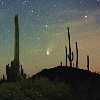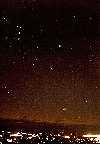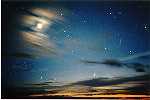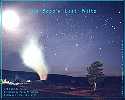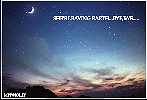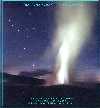 May 11, 1997
04:05 UT
May 11, 1997
04:05 UT
|
The Old Faithful Geyser
Observers: Dewey Vanderhoff, Andrew Frazier
Location: Yellowstone Park, Wyoming
Optics: Nikon F2AS with Micro-Nikkor 35 mm f/2.0 AIS lens, at
2.8 for 35 seconds on Fuji Super G 800.
Hale Bopp certainly turned out to be the "Old Faithful" of comets...for
months we've been able to walk out the door and cast a view to the heavens
and let it fall on a fine comet. This past weekend, we took advantage of
the opening of Yellowstone Park and some exceptionally warm clear calm
weather to make a long-awaited comet run into Yellowstone Park. The Park
is only 50 miles from our town, but is inaccessible to vehicles for months
at a time due to its wilderness nature and winter snow cover.
A heavenly wonder on par with the ice geysers of Neptune's moon Triton
and the sulfur volcano's of Jupiter's Io , the renowned Old Faithful Geyser
in Yellowstone Park, Wyoming hosted Hale-Bopp in clear spring skies on
Saturday May 11.
Although it is small and faint compared to its stellar performance
of just a month ago, Hale Bopp makes a nice dance partner to the geothermal
icon. In order to enhance the geyser's steamy plume and column of water,
Andrew Frazier beamed a 400,000 candlepower onto it , painting the eruption
from a hundred yards away.
Taken during late twilight , the photographer was ninety degrees around
the bend from the spotlight location to get good textural crosslight. From
the time Hale-Bopp became viewable against the dark skies till it set was
less than 40 minutes, and only one eruption of the geyser occured during
that time.
Taken at 10:05 PM-MDT on May 10 (4:05 UT May 11) |

